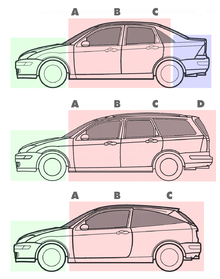Car body configurations

The configuration of a car body is typically determined by the layout of the engine, passenger and luggage compartments, which can be shared or separately articulated. A key design feature is the car's roof-supporting pillars, designated from front to rear of the car as A-pillar, B-pillar, C-pillar and D-pillar.
Common car body configurations are one-box (e.g., a van/minivan/MPV), two-box (e.g., a hatchback/SUV) and three-box (e.g., a sedan/saloon) designs.
One-box design

A one-box design, also called a monospace, mono-box or monovolume configuration
One-box designs include
Two-box design
Two-box designs articulate a volume for engine and a volume that combines passenger and cargo volumes, e.g.,
Three-box design


Three-box design is a broad automotive styling term describing a
Three-box designs are highly variable. Hemmings Motor News said:
These three boxes, compartmentalized as they are, are used to denote distinct areas of an automobile—specifically a sedan. The engine under the hood and surrounding compartment is the first box. The passenger seating area is another, or second box. The last or third box is the cargo or trunk area. There is no rule as to which box needs to be where.[3]
Where the
In 2012, Hemmings Motor News wrote "the three-box sedan design is seen as traditional or—worse—conventional."[3] By 2016 In the United States, the three-box sedan began to wane in popularity.[5][6] In 2018, the Wall Street Journal wrote: "from gangster getaway cars and the Batmobile to the humble family sedan, the basic three-box configuration of a passenger car—low engine compartment, higher cabin, low trunk in the rear—has endured for decades as the standard shape of the automobile. Until now."[5]
Sales and popularity of four-door notchback sedans/saloons began declining in Europe since mid-1990s, especially affordable ones. This is resulted in moving production of Volkswagen Jetta in Mexico, as well as the Peugeot abandoning that segment since 2001 when the production of
Car roof classification
A related classification is based on the style of roof in the car design. The DrivAer aerodynamics model of the Technical University of Munich
Motorsport applications
The bodies of stock cars can be modified for motorsport purposes while retaining their main characteristics. The DrivAer high-performance (hp) configuration,[9] a parametric academic model, provides an open-source wind tunnel dataset and serves as a benchmark, particularly valuable when combined with the original DrivAer Fastback (F) variation variant for aerodynamic analysis. Aero kits applied are in line with those found in motorsport categories like European DTM and American NASCAR series.
See also
- Ponton styling
- Coke bottle styling
- Glossary of automotive design
References
- ^ a b c d "Starting Out: Car Design Glossary - Part 2 pg 3". www.cardesignnews.com. Archived from the original on 4 March 2016. Retrieved 31 May 2018.
- ^ ISBN 0-7603-1712-7.
- ^ a b "Compartmentalized Cars, Boxes and boxes on boxes: the basis of the three-box design". Hemmings Motor News.
- ^ "Fiat Linea". Car Design News. Archived from the original on 2011-07-27. Retrieved 2010-08-06.
- ^ a b "America Has Fallen Out of Love With the Sedan". Wall Street Journal.
- ^ "On the Death of the Sedan". Car and Driver.
- ^ "DrivAer Model". www.epc.ed.tum.de. Retrieved 26 December 2021.
- ^ "DrivAer Model: Geometry". www.epc.ed.tum.de. Retrieved 26 December 2021.
- ^ "SAE MOBILUS". saemobilus.sae.org. Retrieved 2023-12-21.
